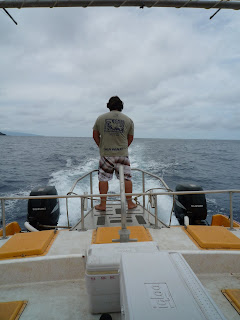 After reading that the famed Big Island artist, Herb Kawainui Kane, was "sickened" by the diacritical mark applied to the new Hawai'i stamp, I learned everything I ever wanted to know about the 'okina and more.
After reading that the famed Big Island artist, Herb Kawainui Kane, was "sickened" by the diacritical mark applied to the new Hawai'i stamp, I learned everything I ever wanted to know about the 'okina and more.Kane created the surfing image for the new first class stamp, which debuts August 21 in honor of the 50th anniversary of Hawai'i's statehood.
Kane said his original rendition of the word Hawai'i was correct but the U.S. Postal Service changed it and erred in making an apostrophe out of what should have been an 'okina.
I confess I stared at this stamp for the longest time, trying to figure out what's what and what's not. When I couldn't see the error, I did a little research.
The 'okina, by the way, is an actual consonant in the Hawaiian language, representing a glottal stop. In Hawaiian the word means a break, and it's what happens when the sound of a vowel is broken off when the glottis, a flap in the larynx, closes off air flow. To illustrate using an English example, it's the sound (or lack of sound) that's made between the two ohs in "oh-oh." In Hawaiian, use of the 'okina is critical in conveying the correct pronunciation and meaning of words, although even in Hawai'i many people seem to consider its use optional.
But how it's represented is up for debate. After considerable research I found it described as an upside down comma, a 9-shaped apostrophe turned 60-90 degrees counter-clockwise, an upside down apostrophe, a little 6 with the circle colored in, a backwards apostrophe, a single open quote mark, and a French accent grave.
Bear in mind that Hawaiian was not a written language until the missionaries, who first arrived in 1820, began writing down words as they heard them. But in the first book written in Hawaiian, the Holy Bible, the missionaries left out both the 'okina and the kahakô, or macron, which indicates a lengthened vowel. So representing these sounds is a relatively new science. A Hawaiian grammar I own that was published in 1939 acknowledges the existence of a glottal stop, but in its lessons rarely applies either the 'okina or the kahakô to the written language.
Kane's complaint was that the mark on the Hawai'i stamp should have been a left-facing 'okina with a weighted bottom, rather than the right-facing apostrophe with a weighted top. It would all seem like much ado about nothing were it not for the fact that the Hawaiian language almost died out in the 20th century -- until it was revived by sticklers like Herb Kane.






